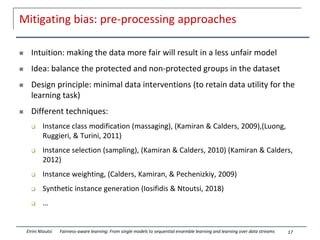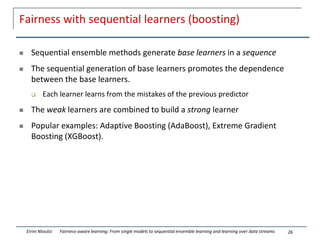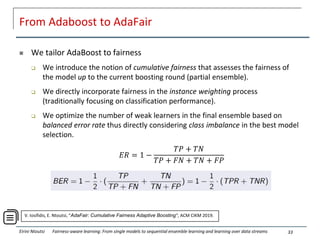The document discusses fairness-aware learning in artificial intelligence, focusing on batch and sequential ensemble learning, and the discrimination that can occur within algorithms. It highlights examples of algorithmic bias and the need for fairness in AI systems, presenting approaches for mitigating bias at various stages of AI decision-making. The presentation emphasizes the importance of understanding and addressing biases in data to ensure equitable outcomes across different demographic groups.






























![Limitations of related work
Existing works evaluate predictive performance in terms of the overall
classification error rate (ER), e.g., [Calders et al’09, Calmon et al’17, Fish et
al’16, Hardt et al’16, Krasanakis et al’18, Zafar et al’17]
In case of class-imbalance, ER is misleading
Most of the datasets however suffer from imbalance
Moreover, Eq.Odds “is oblivious” to the class imbalance problem
32
Eirini Ntoutsi Fairness-aware learning: From single models to sequential ensemble learning and learning over data streams](https://image.slidesharecdn.com/recsgrouptampere-210220154820/85/Fairness-aware-learning-From-single-models-to-sequential-ensemble-learning-and-learning-over-data-streams-31-320.jpg)





![Experimental evaluation
Datasets of varying imbalance
Baselines
AdaBoost [Sch99]: vanilla AdaBoost
SMOTEBoost [CLHB03]: AdaBoost with SMOTE for imbalanced data.
Krasanakis et al. [KXPK18]: Boosting method which minimizes Equalised Odds by
approximating the underlying distribution of hidden correct labels.
Zafar et al.[ZVGRG17]: Training logistic regression model with convex-concave
constraints to minimize Equalised Odds
AdaFair NoCumul: Variation of AdaFair that computes the fairness weights based on
individual weak learners.
39
Eirini Ntoutsi Fairness-aware learning: From single models to sequential ensemble learning and learning over data streams](https://image.slidesharecdn.com/recsgrouptampere-210220154820/85/Fairness-aware-learning-From-single-models-to-sequential-ensemble-learning-and-learning-over-data-streams-37-320.jpg)











![Wrapping-up, ongoing work and future directions
Moving from single-protected attribute fairness-aware learning to multi-
fairness
Existing legal studies define multi-fairness as compound, intersectional and
overlapping [Makkonen 2002].
Moving from fully-supervised learning to unsupervised and reinforcement
learning
Moving from myopic (maximize short-term/immediate performance) solutions
to non-myopic ones (that consider long-term performance) [Zhang et al,2020]
Actionable approaches (counterfactual generation)
54
Eirini Ntoutsi Fairness-aware learning: From single models to sequential ensemble learning and learning over data streams](https://image.slidesharecdn.com/recsgrouptampere-210220154820/85/Fairness-aware-learning-From-single-models-to-sequential-ensemble-learning-and-learning-over-data-streams-49-320.jpg)
